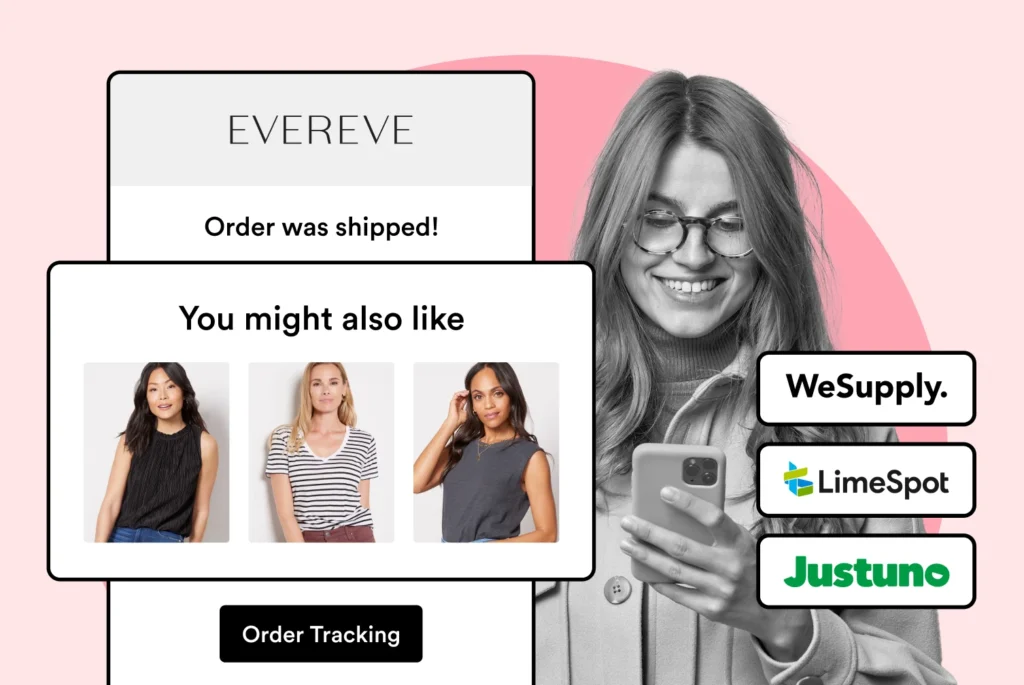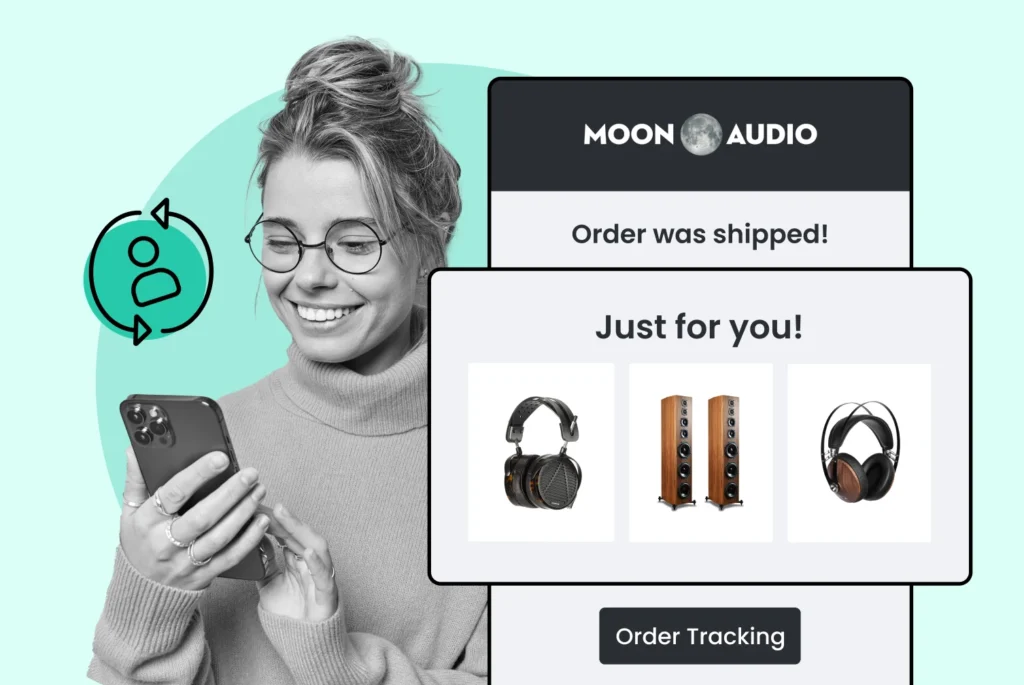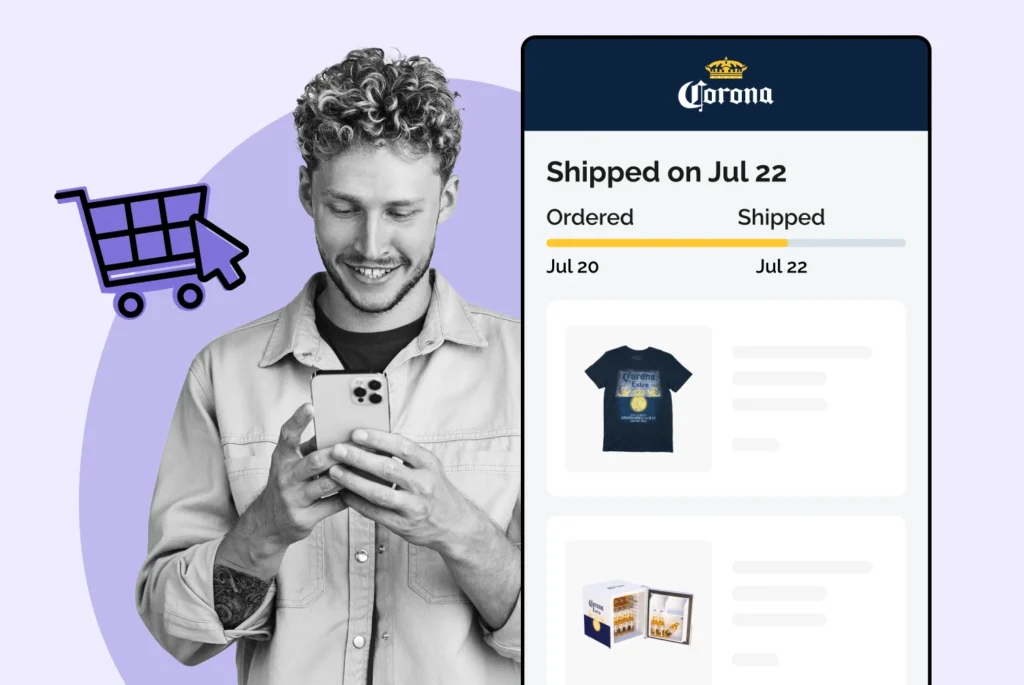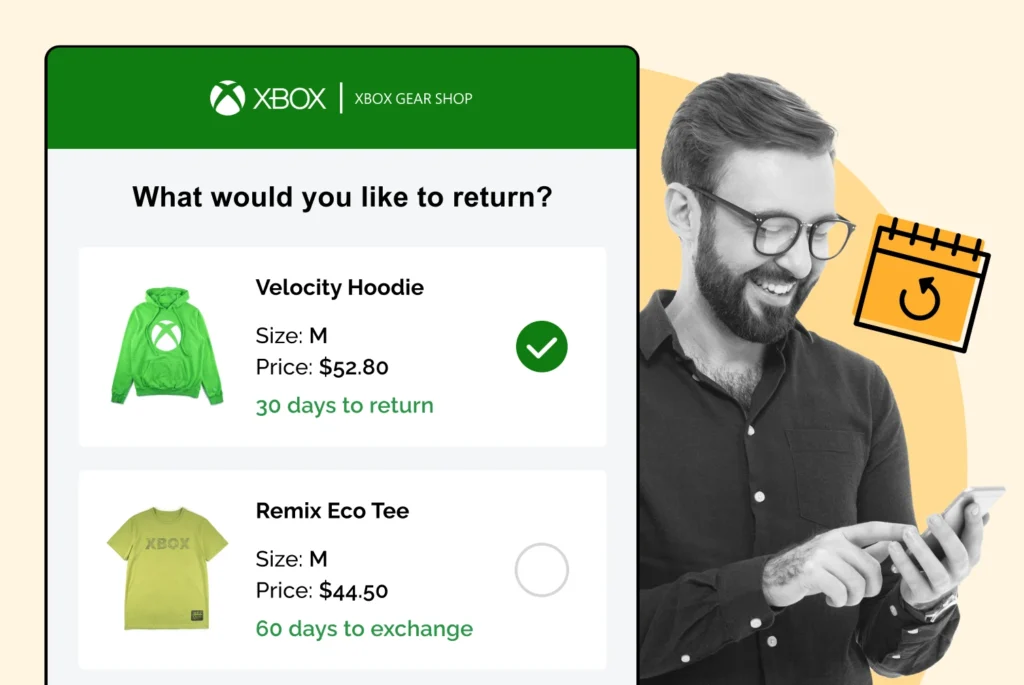
Scalable Ecommerce Technology Stack: Building for Success
Gain insights into selecting the right components and strategies for seamless integration, crucial for both startups and growing enterprises!
Shipping, Tracking & Notifications
Boost customer experience and reduce support tickets
Realtime order and shipment tracking
Proactive order and shipping notifications
AI-Enhanced Discounted Labels
Predictive pre-purchase estimated delivery dates
Self-Serivce branded order tracking
Effortless experience delivered
Identify and Resolve Order Issues
Realtime order and shipment tracking
Make returns profitable and delight customers
Flexibility to define any return destinations & conditions
Simplify returns for your customers and team
Incentivize exchanges over returns
Returns management made easy for your team
Returns management made easy for your team
Easy claims and smart upsells
Understand why your customers are returning
In-Store & Curbside Pickup
Unify the online and the in-store experience
Hassle-free pickup experience for customers
In-Store dashboard to keep operations streamlined
In-Store and Online orders unified
Drive foot-traffic to your stores
Shipping, Tracking & Notifications
Boost customer experience and reduce support tickets
Realtime order and shipment tracking
Proactive order and shipping notifications
AI-Enhanced Discounted Labels
Predictive pre-purchase estimated delivery dates
Self-Serivce branded order tracking
Effortless experience delivered
Identify and Resolve Order Issues
Realtime order and shipment tracking
Make returns profitable and delight customers
Flexibility to define any return destinations & conditions
Simplify returns for your customers and team
Incentivize exchanges over returns
Returns management made easy for your team
Returns management made easy for your team
Understand why your customers are returning
In-Store & Curbside Pickup
Unify the online and the in-store experience
Hassle-free pickup experience for customers
In-Store Dashboard to keep operations streamlined
In-Store and Online orders unified
Drive foot-traffic to your stores
Boost customer experience and reduce support tickets
Realtime order and shipment tracking
Proactive order and shipping notifications
AI-Enhanced Discounted Labels
Predictive pre-purchase estimated delivery dates
Self-Serivce branded order tracking
Effortless experience delivered
Make returns profitable and delight customers
Flexibility to define any return destinations & conditions
Simplify returns for your customers and team
Incentivize exchanges over returns
Returns management made easy for your team
Equip your team for precise return checks.
Easy claims and smart upsells
Understand why your customers are returning
Unify the online and the in-store experience
Hassle-free pickup experience for customers
In-Store Dashboard to keep operations streamlined
In-Store and Online orders unified
Drive foot-traffic to your stores
Find the answer to all your questions
Take a step by step trip through our functionality to see how we can improve your ecommerce processes.
Explore the most comon questions about WeSupply
Calculate the ROI that WeSupply can bring you
Read actionable articles on how to optimize your post-purchase experience and decrease support tickets
Get inspired by stories of how our customers implemented an effortless post-purchase experience
Wondering if WeSupply is a good fit for you? Read through our use cases to see how we can help you increase conversion & improve CX!
A Deep Dive into Top Companies' Order Tracking & Returns Strategy
Find the answer to all your questions
Explore the most comon questions about WeSupply
Calculate the ROI that WeSupply can bring you
Request a no strings attached review of your current shopping experience and missed conversion opportunities
Take a step by step trip through our functionality to see how we can improve your ecommerce processes.
Read actionable articles on how to optimize your post-purchase experience and decrease support tickets
Get inspired by stories of how our customers implemented an effortless post-purchase experience
A Deep Dive into Top Companies' Order Tracking & Returns Strategy
Wondering if WeSupply is a good fit for you? Read through our use cases to see how we can help you increase conversion & improve CX!

As the world emerges from the shadow of COVID-19, one question looms large for businesses and consumers alike: How has ecommerce adapted and thrived in the wake of the pandemic? The intersection of technology, shifting consumer behavior, and the necessity of digital transformation has redrawn the ecommerce landscape, particularly in the context of ecommerce after COVID-19. This article explores these transformative forces, focusing on the innovations, trends, and strategies that online businesses are employing to navigate post-COVID-19 challenges.
The COVID-19 pandemic accelerated ecommerce adoption, with increased online shopping across various categories, a significant shift in consumer shopping behaviors, and an emphasis on personalization using data analytics.
Ecommerce supply chains are evolving to be more resilient and integrated, involving strategic audits, vendor compliance, advanced management systems, and leveraging technology to optimize logistics and distribution.
Technology, particularly AI, ML, digitization, and social commerce, plays a fundamental role in adjusting to post-pandemic retail by enhancing customer experience, improving management processes, and meeting the growing expectations for speed and convenience in delivery.
WeSupply is a key e-commerce solution post-COVID-19, offering predictive delivery dates, omnichannel order tracking, automated pickup notifications, and efficient returns management. Its platform ensures seamless customer interactions through branded communication and proactive notifications, enabling businesses to adapt to contactless and omnichannel retail trends efficiently. This integration of features streamlines the post-purchase experience, catering to the evolving needs of both businesses and consumers in the new retail environment. Transform your post-purchase journey today. Get started with WeSupply for seamless e-commerce solutions!
COVID-19 compelled us to rethink our shopping habits. Social distancing measures led to a meteoric rise in online shopping, with 67% of consumers reporting a change in their shopping behavior. This shift wasn’t confined to established online product categories. Groceries, home goods, and fitness products experienced significant growth, with grocery ecommerce expected to reach 14-18% penetration within the next three to five years. As a result, frequent online shoppers have become a common phenomenon in today’s world, and online shoppers, in general, have embraced this new way to shop online for purchasing goods.
Brand loyalty took a hit during the pandemic. Over 80% of consumers switched brands, influenced by lower prices or out-of-stock products. On the other hand, personalization became more critical as businesses began leveraging analytics to understand customer behavior and create personalized experiences. The shift towards online shopping was so pronounced that online spending increased by nearly 20%, compressing a decade’s worth of digital adoption into just 100 days.
The pandemic underscored the fact that ecommerce supply chains must be dynamic and integrated with overall business plans to address challenges like transportation costs, labor management, and customer demands. Strategic assessments of ecommerce supply chains now include auditing operations, labor use, fulfillment processes, distribution site design, and management systems. Additionally, strategies to make the inbound supply chain more efficient have come to the fore, including assessing vendor compliance, implementing EDI for improved data, and optimizing inbound activities such as labelling or tagging.
Ecommerce businesses have been incentivized to assess service levels, negotiate freight rates, and evaluate the advantages of multi-distribution center operations in an effort to reduce shipping costs and delivery times. A potential method for enhancing distribution center capacity and usage could include reevaluating storage methods, layout, product flow, and material handling equipment to postpone the necessity for transitioning to a new facility. Central to these strategies is the eradication of paperwork and the enhancement of real-time data, realized through the deployment of robust management systems and barcode technologies.
Digitization has become a linchpin of modern ecommerce, streamlining operations and improving efficiency. Transitioning paper documents into digital files offers several benefits, including:
Liberating physical space
Minimizing the demand for physical storage
Cutting costs
Enhancing accessibility, making it easier for employees to retrieve files quickly and collaborate in real time, even remotely.
Moreover, digitization offers increased security through encryption, which protects sensitive information better than physical locks and keys. The process of digitizing documents includes using applications like Adobe Scan to capture physical documents using a mobile device’s camera and convert them into digital formats like PDFs.
Through digitization and digital marketing, ecommerce platforms can leverage artificial intelligence (AI) for personalization, offering products based on a customer’s search history, and improving the customer experience.
Data-driven analytics have become instrumental in understanding and adapting to changing consumer behavior in the post-pandemic retail landscape. Retailers are using data-driven analytics to:
Create personalized online shopping experiences
Utilize customer data to provide tailored recommendations and targeted marketing
Adapt to new shopping preferences, such as an increased demand for health and wellness products and contactless payment and delivery options.
Moreover, analytics aids in forecasting demand, managing inventory levels, and optimizing logistics to ensure product availability and minimize supply chain disruptions in the post-pandemic environment. The use of retail analytics is not without challenges, including data privacy concerns and the need for skilled personnel to interpret complex data sets. Nevertheless, retail analytics is an essential tool for both adapting to current consumer behaviors and anticipating future trends in the post-pandemic retail landscape.
In the evolving retail environment, WeSupply stands out by leveraging logistics analytics to understand consumer behavior post-pandemic. It champions data-driven decision-making, enabling retailers to enhance the post-purchase experience by closely monitoring customer satisfaction and order management metrics. With tools to analyze every aspect of the order process, from receipt to delivery, WeSupply helps businesses adapt to consumer needs and optimize operations. This focus on detailed, actionable insights paves the way for retailers to meet the challenges of a dynamic market, emphasizing the critical role of data in refining customer experiences.
In the realm of ecommerce, last-mile delivery has undergone a significant revolution to meet new consumer expectations. With last-mile delivery accounting for 53% of the total cost of shipping, ongoing inflation has made it more expensive. However, technology has come to the rescue, with enhancements such as predictive analytics and real-time shipment tracking proving critical for improving last-mile delivery efficiency and customer satisfaction.
Consumers now have higher expectations for delivery speed, with same-day delivery becoming increasingly prevalent and expected in urban areas. To meet these expectations, delivery companies are leveraging advanced technologies such as AI and machine learning to optimize routes and improve delivery times, reducing the last-mile delivery challenge. Furthermore, in the wake of the pandemic, contactless delivery options have gained popularity, with consumers preferring to receive packages without direct interaction with the delivery personnel. Some key trends in the delivery industry include:
Same-day delivery becoming the norm in urban areas
Use of AI and machine learning to optimize routes and improve delivery times
Increasing popularity of contactless delivery options
These trends are shaping the future of the delivery industry and are driven by consumer demands for faster and more convenient delivery services.
WeSupply stands as a pivotal solution in aligning with the new consumer expectations in the e-commerce sector, ensuring transparency and trust through every step of the online shopping experience. By integrating predictive analytics for estimated delivery dates and offering detailed ecommerce order tracking, WeSupply alleviates shipping anxiety and promotes customer loyalty.
Key Features:
Display on Product Page, Cart, and Checkout.
Provided on the branded tracking page and in shipment notifications.
Includes estimated delivery date and tracking information.
Proactive Email & SMS Tracking Notifications.
Proactive Order and Shipping Notifications:
Updates on shipping delays or changes via Email & SMS.
These features collectively empower businesses to meet and exceed the evolving expectations of today’s consumers, fostering a reliable and engaging shopping environment. Unlock the future of e-commerce! Book your WeSupply demo now and elevate your customer experience.
The COVID-19 pandemic presented a unique set of challenges to ecommerce businesses. However, technology has been instrumental in overcoming these challenges. The global retail trade’s ecommerce share rose from 14% in 2019 to about 17% in 2020, indicating that businesses and consumers increasingly turned to digital solutions during the pandemic. This digital transformation wasn’t a luxury but a necessity for survival, resulting in a significant increase in the number of businesses selling online.
Emerging economies experienced a substantial shift towards online shopping, with a doubling of items sold per day on Latin America’s Mercado Libre and a 50% jump in transactions on Africa’s Jumia platform during the early months of the pandemic. Large digital platforms, especially those offering e-commerce, teleworking, and cloud computing solutions, benefited the most from the pandemic, potentially entrenching their dominant positions.
The pandemic has also led to a reevaluation of supply chain practices, with a focus on balancing efficiency with the ability to withstand and recover from shocks, including through ongoing policy efforts to strengthen and diversify supply chains.
In the wake of pandemic-induced challenges, WeSupply has emerged as a crucial post-purchase software, enabling businesses to embrace technology for seamless e-commerce operations. By offering seamless returns and exchanges, predictive delivery dates, comprehensive order tracking, and proactive communication through email and SMS notifications, WeSupply helps retailers overcome obstacles to customer satisfaction and logistics efficiency. This platform is a testament to the power of technology in adapting to and overcoming the dynamic challenges of the e-commerce landscape, ensuring businesses can meet evolving consumer expectations with confidence.
Incentivize exchanges over returns
Book a quick call with our experts to see how WeSupply can help you save sales through exchanges and boost the average order value using instant store credit.
Even in the face of pandemic-induced obstacles, ecommerce has demonstrated exceptional resilience and expansion. The global retail ecommerce sales are forecasted to grow steadily by 8% through 2024, signaling a persistent rise in overall retail sales due to the paradigm shift caused by COVID disruptions. This growth is partly driven by businesses adapting to new digital needs and incorporating technologies into their operations.
Pandemic-related restrictions on in-person activities have led businesses to rely on ecommerce sales channels for survival, resulting in a significant increase in the number of online retailers. In addition, there was an anticipated 19% increase in worldwide commerce sales revenue between pre-and-post COVID-19 timeframes in 2020, with Food & Personal Care products showing the most growth due to a shift to online sales channels.
As consumer priorities have evolved during the pandemic, innovative product trends and categories have surfaced in the ecommerce domain. Accelerated use of mobile shopping is a significant trend, as mobile commerce includes not only purchasing but also engagement with ads, sales interactions, and browsing on smartphones. Social commerce is also evolving, with a large percentage of consumers planning to make purchases through social platforms, facilitated by features such as Instagram Shop and Facebook Shops.
Personalization in shopping has become a preferred experience, with consumers more likely to remain loyal to brands that offer a personalized shopping experience, including product recommendations and a seamless retail experience across multiple channels. Additionally, consumers are increasingly choosing to spend their money on brands that align with their values and beliefs, with a significant number of consumers likely to increase spending with such brands.
Personalization does not stop after checkout; it extends into the post-purchase journey, enhancing customer loyalty and brand connection. WeSupply recognizes this by offering features that maintain a consistent, branded experience beyond the point of sale.
Features include:
Branded Returns Portal: Boosts customer loyalty by offering an easy, branded solution for returns, avoiding the confusion of third-party courier pages.
Post-Purchase Notification: Engages customers with email and SMS notifications, boasting high open rates and offering personalized deals to encourage repeat business.
Buy Online Pickup in Store: Simplify pickups with automatic SMS and Email alerts when orders are ready. Customers receive location details and a one-time PIN for a hassle-free pickup experience.
Buy Online Pickup at Curbside: Enhance convenience with automated notifications for pickup readiness and customer arrivals. Our system ensures a quick, seamless check-in process that improves satisfaction and drives repeat business.
These tools demonstrate WeSupply’s commitment to personalizing the shopping experience from start to finish, ensuring customers remain connected and satisfied with every interaction. Start personalizing your post-purchase journey today. Get started with WeSupply and transform your customer experience!
Following the pandemic, options for contactless payment and delivery have established themselves as the new norm in ecommerce. Nearly 95% of tested dollar bills harbor bacteria, leading to concerns about the cleanliness of cash and contributing to the rise in contactless payments. Digital payments increased during the pandemic not only due to a surge in online shopping but also due to consumers’ continued preference for contactless methods even after returning to in-person shopping.
Frictionless payments such as:
digital wallets
tap-to-pay cards
in-app payments
social payments
As more people continue shopping online, it is becoming integral to the consumer checkout experience across various purchasing platforms, including in store shopping, to provide a seamless online shopping experience through an efficient online shopping process.
On the delivery front, the global autonomous last-mile delivery market is projected to reach a value of $90.21 billion by 2030, showcasing the significance of innovations in contactless delivery technology.
WeSupply’s integration with Clover marks a significant step forward in the evolution of contactless transactions, setting a new standard in payment processes. By combining WeSupply’s seamless post-purchase experience with Clover’s all-in-one payment solutions, from virtual terminals to POS systems, businesses are empowered to offer a streamlined, safe, and efficient shopping journey. This partnership is a testament to the rising demand for contactless options, ensuring that retailers can meet the needs of the modern consumer with confidence and ease.
In response to evolving consumer requirements and preferences, businesses have adopted pioneering fulfillment strategies like curbside pickup and delivery collaborations. Curbside pickup gained significant popularity during the COVID-19 pandemic as a way to minimize virus transmission and has remained a popular shopping method post-pandemic. Retailers like Walmart, Kroger, and Whole Foods have incorporated innovative in-app check-in processes to streamline the curbside pickup experience.
The United States has experienced the largest and fastest-growing pickup economy per capita, with a 37% increase from 2021 to 2023 in eCommerce shoppers using in-store or curbside pickup. Around two-thirds of millennial consumers in the U.S. preferred curbside pickup for online purchases in 2022, indicating a strong consumer preference for this service.
WeSupply is leading the charge in innovative fulfillment strategies, adeptly adapting to consumer preferences for convenience and efficiency with options like curbside pickup and delivery partnerships. By embracing these modern solutions, WeSupply ensures businesses can meet the evolving needs of their customers, providing a seamless and satisfactory shopping experience.
Features include:
Buy Online Pickup in Store: Automated notifications via SMS and email when orders are ready, including pickup instructions and a one-time PIN code for secure collection.
Buy Online Ship to Store: Facilitates shipping to store for pickup, reducing costs and driving additional revenue through increased in-store foot traffic.
Buy Online Return in Store: Encourages in-store returns to drive foot traffic and revenue, offering an easy return process with pre-approved returns and clear instructions on eligible stores.
Buy in Store Return Online: Simplifies returns and exchanges for in-store purchases through online processes, enhancing customer loyalty and unifying the shopping experience.
These features not only cater to the convenience and flexibility demanded by today’s consumers but also foster loyalty and repeat business through an enhanced post-purchase experience. Discover the future of fulfillment. Book your WeSupply demo today and elevate your customer experience!
Social media platforms are playing an increasingly influential role in shaping shopping behavior, driving the growth of social commerce. Gen Z and Millennial shoppers (ages 18-41) are twice as likely than older generations to be influenced by video and social media in their purchase decisions. Consumers have developed deep relationships with social media creators, leading to trust in their recommendations, effectively serving as a new form of ‘try before you buy’.
YouTube has been a pioneer in social commerce, with its creators establishing trust with viewers, which translates into long-term value for retailers. Shoppable ads on YouTube can reduce friction in the shopping journey, with 74% of Gen Z consumers (ages 18-25) stating that YouTube content makes them feel more confident in what they buy.
The persistent implications of COVID-19 on consumer trends and supply chains necessitate that businesses maintain their agility and responsiveness to change. The pandemic caused a shift in consumer demand towards goods and away from in-person services, which, coupled with supply chain disruptions, led to inflationary pressure globally.
To navigate these challenges, businesses should consider the following strategies:
Maintain a diverse range of suppliers to ensure resilience and adaptability to shocks.
Continuously monitor and analyze consumer trends to anticipate changes in demand.
Implement flexible production and distribution systems to quickly respond to fluctuations in demand.
Strengthen communication and collaboration with suppliers to address potential disruptions and delays.
Invest in technology and digital solutions to enhance supply chain visibility and efficiency.
By adopting these strategies, businesses can better navigate the uncertainties and challenges brought about by the pandemic and ensure their long-term success.
The concept of supply chain resilience has become more prominent, focusing on the ability to quickly recover from unexpected events, which can be enhanced through better data, investments in redundancy, and improved communication across the supply chain. The pandemic highlighted the fragility of highly-efficient but intricate global supply chains, as disruptions at individual firms could lead to broader economic impacts.
Omnichannel strategies that blend digital and physical retail experiences, including brick and mortar stores as well as physical stores, are crucial for success in a post-pandemic world. Successful technology transformations in ecommerce require businesses to manage a complex set of interdependencies between systems and initiatives across IT and the business.
A Tech:Forward framework for building a flexible, tech-forward ecommerce strategy includes three interconnected vectors:
Reimagining technology’s role focused on the business
Developing a technology delivery model for flexibility and speed
Creating a future-proof foundation of core tech systems.
Understanding the customer journey in Omnichannel contexts is crucial, including the design and redesign of journeys through the selection and management of touchpoints. The evolution of the customer journey, influenced by the pandemic, has shown how circumstances can alter customer journeys, sometimes restricting access to certain touchpoints or channels and forcing exploration of new alternatives.
In the evolving landscape of digital and physical retail, WeSupply stands out as a key post-purchase software for omnichannel strategies. It simplifies order tracking by centralizing data from various channels like websites, phone orders, and marketplaces into a single, seamless customer portal. This ensures that customers have a consistent and reliable way to check their orders, enhancing the shipping process with timely updates and a positive brand experience. WeSupply is essential for retailers seeking to blend digital and physical touchpoints effectively in a post-pandemic world.
The development of a flexible, tech-forward ecommerce approach is crucial for businesses in their preparation for and adaptation to forthcoming challenges and opportunities. Successful technology transformations in ecommerce require businesses to manage a complex set of interdependencies between systems and initiatives across IT and the business.
A Tech:Forward framework for building a flexible, tech-forward ecommerce strategy includes three interconnected vectors:
Reimagining technology’s role focused on the business
Developing a technology delivery model for flexibility and speed
Creating a future-proof foundation of core tech systems.
The key trends in ecommerce include:
The implementation of Artificial Intelligence (AI) and Machine Learning (ML), enhancing personalization and optimizing the supply chain
As we’ve explored throughout this post, the ecommerce landscape has undergone a significant transformation in the wake of the COVID-19 pandemic. From the evolution of ecommerce and the reinvention of supply chains to the rise of contactless payment and delivery options, businesses have had to adapt and innovate to meet changing consumer needs and expectations. As we move forward, it’s clear that a flexible, tech-forward ecommerce strategy is essential for success in this new era of retail.
WeSupply positions itself as a comprehensive solution for e-commerce resilience post-COVID-19, blending advanced technology and insightful analytics to meet new consumer demands. It offers a suite of features designed to enhance the post-purchase experience, streamline operations, and integrate seamlessly with existing systems. These include predictive estimated delivery dates, centralized omnichannel order tracking, automated store and curbside pickup notifications, and efficient returns management. With capabilities for branded tracking and returns portals, as well as proactive email and SMS notifications, WeSupply empowers businesses to adapt to the shift towards contactless transactions and omnichannel strategies, ensuring customer satisfaction and loyalty in a rapidly evolving retail environment. This suite of tools is pivotal for businesses aiming to navigate the post-pandemic e-commerce landscape with confidence and strategic insight.
Combat inconvenience with proactivity & self service
Book a quick call with our experts to see how WeSupply can help you make returns easy for your customers with a beautiful, self-service solution that makes their experience easier while also providing new ways to lower costs and earn back revenue.
COVID-19 has significantly accelerated the growth of e-commerce, with a 44.5% increase in year-over-year sales in Q2 2020, compared to a 3.5% decline in the overall retail sector. (No date)
Yes, e-commerce is growing rapidly. The global e-commerce market is expected to grow from $5.2 trillion in 2021 to about $8.1 trillion by 2026, with the number of digital buyers worldwide consistently increasing.
Supply chains in the ecommerce industry have adapted to the pandemic by emphasizing resilient and flexible strategies, including reassessing storage methods, optimizing inbound activities, and implementing robust management systems and barcode technologies.
WeSupply enables businesses to meet evolving consumer expectations for contactless transactions and omnichannel retailing, streamlining customer interactions through branded communication and proactive notifications.
WeSupply offers a Branded Returns Portal, making the returns process efficient and driving customer loyalty by providing a seamless, branded experience.
By centralizing orders from various channels and providing consistent updates and tracking information, WeSupply supports a seamless omnichannel experience for customers, regardless of where they make their purchase.

Learn How To Create Successful Post Purchase Email Campaigns
Build an effective post-purchase email flow that helps you increase customer satisfaction and drive revenue growth!
Consumers seek the best deals on:

Gain insights into selecting the right components and strategies for seamless integration, crucial for both startups and growing enterprises!

Learn why small enterprises are uniquely positioned to personalize, specialize, and swiftly adapt in ways Amazon simply can’t match!

Shipping insurance: its importance, coverage specifics, cost factors, strategic integration into your shipping insurance e-commerce model.

Let’s delve into return windows, their influence on brand loyalty, and the balancing act businesses perform when setting these timeframes.

Let’s target the core of cross-border e-commerce for Canadians, outlining how shoppers leverage the global market! What you need to know.

Strategies to navigate and maximize digital sales channels, optimize mobile commerce, and establish a strong direct-to-consumer foundation!

This article will teach you how to grow while staying sustainable as consumers increasingly favor responsible brands.

Let’s delve into return windows, their influence on brand loyalty, and the balancing act businesses perform when setting these timeframes.

Effective strategies for mobile return optimized returns in e-commerce: enhance customer satisfaction and streamline your operations!